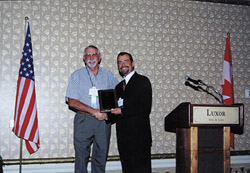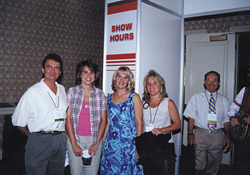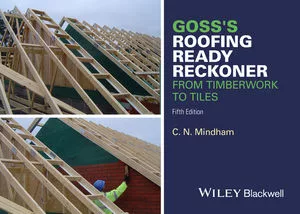Postcard from Las Vegas
ICAA executive director Michael Kwart reports that attendance exceeded 500, making the exhibit area a lively place. “The contractors saw a lot of new companies at the trade show,” he notes. “We had 61 booths — a new record for us.”
One highlight from the awards ceremonies was the presentation of the association’s Key Man award — or more accurately this year, the Key Men Award. Ray Usher (Superl Inc., Minneapolis) and Roger McKenzie (McKenzie Insulation, Kennesaw, Ga.) both were cited for their contributions this past year. They’ve done an extraordinary amount of work to advance the industry — particularly in the areas of master specification issues, contractor certification and Website development.

Legal Issues Tackled
Very well received was the educational program “Lawsuit Epidemic — How to Insulate Your Company from Construction Defect Lawsuits,” presented by Marshall Hopper (Hopper Construction & Consulting, Hillsborough, Calif.) and Ron Cook (law firm Willoughby, Stuart & Benning, San Jose, Calif.). Some highlights excerpted from that presentation:These days, builders and owners have higher expectations, the dollar amounts involved are on the rise, and we’re living in a rather litigious society. That means more and more projects go to construction defect litigation, and most participants in the project will become involved. The general isn’t going to want to take the full hit so everyone else will get dragged down with it in an effort to spread the burden.
It’s a good idea to develop the mindset that you assume every project you’re on will lead to a suit. This helps keep you on your toes and make prevention tactics a priority. Do everything you can up front because as a subcontractor, you have little control over matters once the lawsuit begins.
- Your proposal and subcontract scope of work description should be very specific and clear, spelling out the agreed responsibility — traditional insulation tasks, as well as rarely mentioned items such as firestopping and warm-side vapor retarders. You have to consider these things when you go through plans and specs for your takeoffs, so you might as well put it into the proposal. Get as much detail as possible into the proposal, and then stick by what you say you’re going to do and what you’re not going to do. Don’t make changes without doing so in writing.
Then make your proposal an exhibit to the general contractor’s subcontract to you. All it takes is a simple statement in the general contractor’s contract, signed by everyone that your proposal becomes an exhibit of that contract. And it should state that your proposal takes precedence if any complication or confusion should arise.
Add a statement in your proposal and contract that items not specifically included in the scope are not included in the contract, regardless of what it says in the plans and specs. Too often, all that contracts say regarding scope of work is that you “will do all the insulation on this project per plans and specs.” That is subject to a great deal of interpretation. It would be much better if, as you’re doing your takeoff, you write it out so you can put it into the proposal, specifically including, or excluding, the various items that arise. It can help later when people forget about the arrangements that were made when you took the job.
- You should have solid quality control of workmanship at the job site. Make certain your crews understand the importance of complete and thorough work and the potential significance of a missed area. The way construction litigation goes, testing and sampling are done in small areas of the building project. If something is found missing or otherwise a problem, that result gets extrapolated across the whole project. So one area that is missing or poorly done can be very expensive. Remind the crews that the future health of the company is important to their future.
- Avoid questionable projects, such as those with developers and generals that have low standards. Projects with substandard roofing, waterproofing or sheet metal subs are likely to be litigation targets later when the leaks start to show up. Then all the subs on the project will face trouble.
- Know local codes and industry standards for your work, and be aware of any changes.
- Work with your local building officials — before and during inspections. Don’t be afraid of them; it’s better to find out right on the spot whether they’ll accept what you’re doing. Keep a record of it. Put a memo in the file that you had a conversation with a building inspector who said this isn’t required or that is required, or whatever.
- Inspect all insulation work immediately prior to close-in and be prepared for on-the-spot corrections. Plenty of times the insulation is properly installed but then gets moved by some other tradespeople or even the wind — and nobody cares because the supervisor isn’t on the job anymore. So the drywall goes up and you’re the one in trouble if the insulation is later found to be missing.
- Maintain complete and accurate project records, including field sheets of work done by task, date and lot number or address. It’s not uncommon for lot numbers, addresses and even street names to change from when they are first assigned. If litigation pops up 10 years down the line, your records will be able to establish what work you did or didn’t do and separate your work from that of other insulation contractors.
- Also, keep your contract and billing and payment records, product information cutsheets, change orders, job memos and records of verbal conversations. Develop a good system for locating those records later — lawsuits can come up to 10 years or more after the fact.
- If you are going to make changes in the plans and specs, be sure to get specific approval for those changes in writing from the general contractor, and keep it in your files — or don’t make the change. Otherwise you’ll be held responsible for all of the original plans and specs. And keep in mind that 10 years after a project is completed, the people that had the conversations and either agreed or disagreed with the situation may well not be available anymore. If a change is not in writing, all anyone has upon revisitation is the original spec.
- If the project task sequencing or scheduling presents a problem, such as the drywallers closing up a wall before you can finish the insulation, be sure to issue a memo to the GC. Try to get that undone but if you have to, just issue a memo to the GC and get it signed. And of course, keep the memo in the job file.
- Be aware of any other insulation subcontractors involved with the project. Believe it or not, there are insulation contractors out there that don’t do a good job.
- Take pictures or otherwise document typical or specific locations of firestopping installation locations. Or develop a typical location plan with your installation crews and keep it in your records. That way, if it comes up later, you can say, “It’s there in this part of the wall.” It gets opened up, there it is and you don’t have a problem. Otherwise if you don’t know where to look, there’s a lot of places where fireproofing can be found and there’s no way to find it without opening up the walls.
- Be sure of the types of recessed lights that actually are used on a project, not just what it says on the plans and specs — especially on an attic blow. If you put the blow on the wrong kind of lights, you’re going to be in trouble.
- Be careful not to block attic or crawlspace vents, or cover heating or sprinkler components. Insulation contractors have paid for having little tufts of insulation on the sprinkler heads because there is no way anyone can say that that can’t affect the operation of the sprinkler head.
- If hardboard siding is installed on the project — and it will be there before you insulate the walls — be sure to specifically include or exclude the installation of warm-side vapor retarders in your contract. And be sure the GC understands and agrees with your proposal. If you are going to install faced batts, be sure to install them properly to satisfy the hardboard siding manufacturers’ requirements for the vapor retarder. Otherwise, tell the GC that what you’re putting in is not the equivalent of a warm-side vapor retarder. Do not install faced batts anywhere the facing will be in the open because of the flame spread danger.
Hopper and Cook covered several other important issues, and their Q&A session was especially interesting. Their presentation was definitely a hit.

I’ve Got an Idea
George Hedley (Hedley Construction, Newport Beach, Calif.), a familiar face at ICAA conventions, delivered another good presentation — this time with an interactive roundtable seminar on best practices of successful insulators. Contractors were set up in about 10 roundtable groups, mercilessly harassed by Hedley and then asked to brainstorm.A debriefing of the roundtable discussions revealed five key challenges facing insulation contractors today:
1. Finding, training and keeping qualified labor.
2. Competing with unqualified fly-by-nighters and lumberyards.
3. Dealing with general contractor incompetence.
4. Getting accounts receivable paid — and on time.
5. Preventing lawsuits and insurance problems.
After enduring further good-natured torment from Hedley, the groups then came up with a list of solutions to help meet those challenges:
1. Excellence in training. This is rather obvious and plays a part in nearly every other suggestion offered.
2. See about opening a branch location where unemployment is higher.
3. The new wave of immigrants can be tapped for recruiting. Consider offering tutoring in English.
4. Owners should try to become as hands-on as possible. Customers like it and the owner is more tuned in to the everyday business.
5. Diversify the products and services you offer — and cross-train your employees accordingly.
6. Make employee bonuses quarterly, monthly or weekly instead of yearly. That keeps the incentive fresher in their minds.
7. Dinners, lunches, Gatorade, picnics, parties, outings, etc. boost morale.
8. Keep your prices up. Don’t lower prices because you lose a few jobs. Your bids should be profitable.
9. Build value in your business — it’s best for the long run.
10. Nurture builder relationships more.
11. Stay on top of scheduling to eliminate wasted time.
Looking Ahead to 2001
Next year, the ICAA will be led by Ginny Cameron (A.C. & R. Insulation Co., Beltsville, Md.), who takes over as association president January 1. We wish her the best of luck (even though she clearly doesn’t need it) and look forward to working with her and the other 2001 officers, who will be determined by the ICAA board later this year.
The ICAA’s next convention and trade show takes place October 18-20, 2001, in St. Louis.
Looking for a reprint of this article?
From high-res PDFs to custom plaques, order your copy today!







